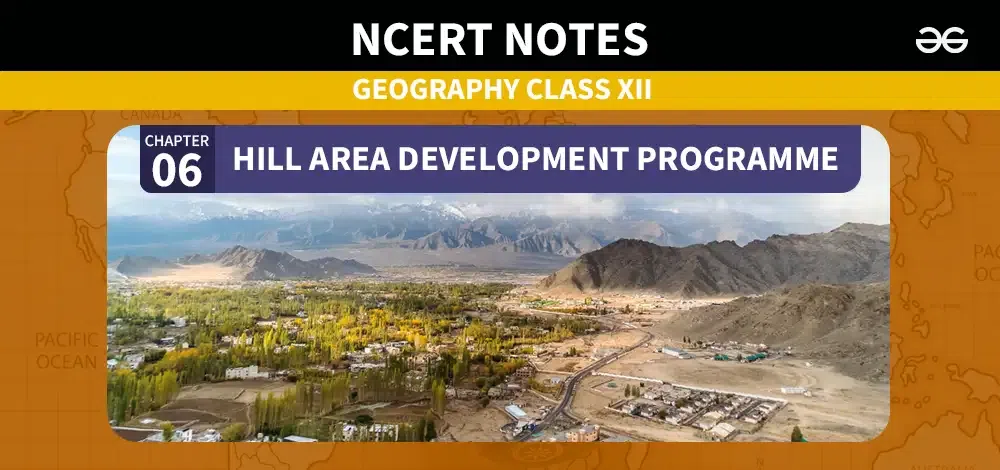Class 12 Geography Notes Chapter 6 Hill Area Development Programme
Last Updated :
24 Apr, 2024
The Hill Area Development Programme (HADP) was initiated during the Fifth Five Year Plan in India, targeting specific hilly districts across the country. This article explores the objectives, coverage, and strategies of the HADP, highlighting its significance in addressing the socio-economic challenges prevalent in hill regions.

Class 12 Geography Notes Chapter 6 Hill Area Development Programme
Hill Area Development Programme
During the Fifth Five Year Plan, the Hill Area Development Programmes were initiated, targeting 15 districts encompassing all the hilly districts of Uttar Pradesh (now Uttarakhand), Mikir Hill and North Cachar hills of Assam, Darjeeling district of West Bengal, and Nilgiri district of Tamil Nadu. In 1981, the National Committee on the Development of Backward Areas recommended that all hill areas in the country with elevations above 600 meters, not covered under the tribal sub-plan, should be considered as backward hill areas.
These development programs were meticulously designed considering the unique topographical, ecological, social, and economic conditions of the hill regions. The primary objective was to utilize the indigenous resources of the hills effectively by focusing on the development of horticulture, plantation crops, agriculture, animal husbandry, poultry farming, and forestry, and promoting small-scale and village industries.
Origins and Coverage
During the Fifth Five-Year Plan, the HADP was launched to promote development in 15 districts encompassing hilly areas. These districts included the hilly regions of Uttar Pradesh (now Uttarakhand), Mikir Hills, North Cachar Hills in Assam, Darjiling district in West Bengal, and Nilgiri district in Tamil Nadu. The program was established to address the unique challenges faced by these hilly terrains, which often lagged in terms of socio-economic development.
Recognition of Backwardness
In 1981, the National Committee on the Development of Backward Areas recommended the identification of all hill areas with an elevation above 600 meters as backward hill areas. This recognition underscored the need for targeted development interventions in these regions to uplift their socio-economic status and improve the quality of life for the residents.
Objectives and Planning
The development plans for hill areas were meticulously crafted, taking into account their topographical, ecological, social, and economic characteristics. The overarching goal of the HADP was to harness the indigenous resources of these regions for sustainable development. Key objectives included the promotion of horticulture, plantation agriculture, animal husbandry, poultry farming, forestry, and the establishment of small-scale and village industries. By leveraging local resources and traditional knowledge, the programme aimed to create employment opportunities and enhance income levels in hill communities.
Focus Areas
HADP placed significant emphasis on the development of specific sectors tailored to the unique requirements of hilly terrains. Horticulture emerged as a crucial focus area, with efforts directed towards the cultivation of fruits, vegetables, and medicinal plants suited to the local climate and soil conditions. Plantation agriculture, including tea cultivation in regions like Darjeeling and Nilgiri, played a pivotal role in generating income and supporting livelihoods. Additionally, animal husbandry, poultry farming, and forestry activities were promoted to diversify rural livelihoods and enhance resilience against environmental challenges.
Small-Scale and Village Industries
Recognizing the importance of fostering entrepreneurship and local industries, HADP facilitated the establishment of small-scale and village enterprises in hill areas. These industries encompassed sectors such as handicrafts, handloom weaving, sericulture, and agro-processing, leveraging the region’s rich cultural heritage and natural resources. By encouraging value addition and market linkages, these initiatives aimed to create sustainable livelihood opportunities and boost economic growth in hill communities.
Conclusion
The Hill Area Development Programme represents a targeted approach towards addressing the developmental needs of hilly regions in India. By recognizing the unique challenges and opportunities inherent to these areas, the programme strives to unlock their socio-economic potential through strategic interventions in sectors like horticulture, agriculture, animal husbandry, and small-scale industries. Moving forward, sustained efforts and investments are essential to ensure the inclusive and sustainable development of hill areas, thereby improving the lives of residents and fostering environmental stewardship.
Chapter 6 Hill Area Development Programme- FAQs
What is the Hill Area Development Programme (HADP) and when was it initiated?
The HADP is a government initiative launched during the Fifth Five Year Plan in India to promote development in hilly districts. It aims to address the socio-economic challenges prevalent in these regions through targeted interventions.
Which districts are covered under the Hill Area Development Programme?
The HADP covers 15 districts across India, including hilly areas of Uttar Pradesh (now Uttarakhand), Mikir Hills, North Cachar Hills in Assam, Darjiling district in West Bengal, and Nilgiri district in Tamil Nadu.
Why were hill areas with elevations above 600 meters identified as backward hill areas?
The National Committee on the Development of Backward Areas recognized hill areas with elevations above 600 meters as backward due to their socio-economic challenges. This identification aimed to prioritize targeted development interventions to uplift these regions.
What are the main objectives of the Hill Area Development Programme?
The primary objectives of the HADP include harnessing indigenous resources for sustainable development, promoting sectors like horticulture, agriculture, animal husbandry, and small-scale industries, and creating employment opportunities in hilly regions.
Which sectors receive focus under the Hill Area Development Programme?
HADP places significant emphasis on sectors such as horticulture, plantation agriculture, animal husbandry, poultry farming, forestry, and small-scale and village industries. These sectors are tailored to the unique requirements and resources of hilly terrains, aiming to improve livelihoods and foster economic growth in hill communities.
Share your thoughts in the comments
Please Login to comment...